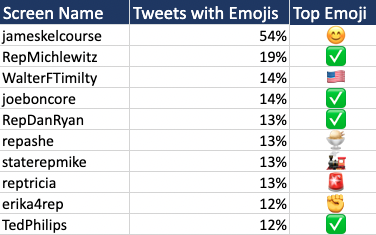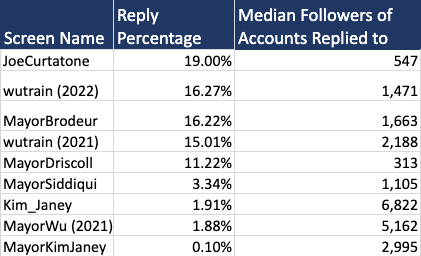Using data (and tens of thousands of tweets) to see how Mayor Michelle Wu stands out in her social media use
When Michelle Wu was elected Mayor of Boston, some of the news coverage focused on her age. She is the youngest mayor among the United States’ 25 largest cities and at the forefront of Millennials who are gaining positions of prominence in elected office across the country.
Other articles, including one last week from the Boston Globe, highlighted her use of social media – from Instagram Live sessions to a Twitter account with 133,000 followers - as one way her governing style is distinctive.
But this leads to some questions.
Is she really unique in her social media use or is this a product of our eyes deceiving us? Twitter’s algorithm may be driving more attention to her account from Boston reporters even if she’s similar in her activity to other mayors.
Is this how most millennial elected officials act and she’s the first one to gain enough prominence for it to be noticeable? Or is this a trend of social media use that elected officials of all ages have adopted and, again, she’s the one who is getting noticed for it?
If she does use social media differently, how so? Is it about tweeting a lot more than others or are there differences within the tweets?
Are there significant differences between her personal/campaign account (@wutrain, with 133k followers) and her official Mayoral account (@MayorWu, 49k followers)?
Luckily, tweets are publicly available and we can compare hers to those of other mayors in the Boston area and tweets from state legislators in Massachusetts.
We compared Mayor Wu’s tweets to Boston Mayor Kim Janey’s official and campaign accounts, Mayor Joe Curtatone of Somerville, Mayor Paul Brodeur of Melrose, Mayor Kim Driscoll of Salem, and fellow millennial Mayor Sumbul Siddiqui of Cambridge. We collected the most recent 1,000 tweets sent from their accounts from January 1, 2021 to January 3, 2022.
So what are the results
Language in the Tweets – emojis
One of the clearest divides is how people write tweets is the use of emojis. The Millennial accounts used emojis in 16-18% of all tweets. The Gen X accounts used them in less than 10% of tweets.
Does this mean that Millennial elected officials are less formal online? Perhaps. For the two Boston mayors, emojis are used less in official accounts than in campaign accounts.
But it could also mean that social media is used differently in general. Mayor Siddiqui’s most used emoji is the pointing finger, generally used when retweeting something. Mayors Driscoll and Curtatone also use pointing fingers, but to a much smaller extent. While anyone could use emojis, it seems like it’s simply a more common part of the vocabulary of younger mayors, even in a simple act like retweeting.
Members of the Massachusetts State Legislature don’t seem to be big emoji users. Of the 49,999 tweets sent between Jan 1, 2021 and Jan 3, 2022, only 4% contained an emoji.
The most popular emojis were the checkbox (by a long way), the American flag, and the siren.
However, the State House does not see such stark differences in the age of emoji users. While the most frequent emoji users do include some of the younger members of the chamber, there is not such a clear difference. That may be that at the state level that younger staffers influence social media style, that state-wide legislators use social media differently, or simply the randomness of a sample size of only 200 legislators.
When are the tweets sent?
Mayor Wu is a high-volume tweeter, compared to her contemporaries. In December, her first full month in office, @wutrain sent 275 tweets, @MayorWu sent 128 tweets, and the next closest was @MayorDriscoll with 168.
Perhaps more importantly in terms of driving engagement, Mayor Wu tweets consistently throughout the day, with her personal account particularly active outside of work hours. Other elected officials tend to tweet during work hours, dropping off dramatically at night.
Is it for announcements or conversations?
If you follow an elected official, you’ll often see tweets that look like mini press releases. An announcement of a new policy, declaring a stance on an issue, or congratulating a person/group/organization on an accomplishment.
Twitter can also be used to engage in public conversations and reply directly to constituents (or dunk on opponents).
We see that Michelle Wu is among the higher repliers, with 15% of her tweets being replies to others. This is not the highest of all – Somerville Mayor Joe Curtatone was the most likely to engage in conversation on Twitter – but significantly higher than others and her official account. Her replying habits have increased in 2022. Although a smaller sample size, we conducted a separate analysis on her @wutrain tweets since January 3 and see a slight increase in replying.
We also see that the accounts she replies to have a wide range of followers. This tells us that she’s not simply replying to big accounts, like media personalities or other elected officials. However, in this regard, Mayor Driscoll and Mayor Curtatone typically reply to the smallest accounts, perhaps an indication that mayors of smaller cities have different social media audiences.
Is she replying only to supporters or opponents?
The Globe article mentioned how Mayor Wu will occassionally use Twitter to engage with complaints and debate opponents. While we can’t look at every tweet and classify it as a complaint or not, we can use the average sentiment of the words in the tweets mayors reply to as a proxy for what kind of tweets they’re interacting with.
Sentiment analysis uses a dictionary of words scored by how positive or negative they are. So a tweet with a lot of positive words (“great”, “fantastic”, “congratulations”) will have a higher average sentiment than a tweet with negative words (“terrible”, “awful”, “catastrophe”). This is only a proxy, of course, since it doesn’t account for sarcasm or tweets praising an elected official for dealing with crises or problems, which would be scored as negative.
Of course, there is a caveat. In 2021, Wu won her election. Praise flowed in on Twitter and she replied to some of it. Her @wutrain replies since 2022 started have been much lower in their average sentiment, towards the middle of the mayoral pack. The same is true in her quote tweets (re-tweets that respond to another’s tweet – it’s similar to a reply but gives more visibility to the original tweet). Out of 73 quote tweets since January 3, only four were in response to criticism.
Of course, there is a caveat. In 2021, Wu won her election. Praise flowed in on Twitter and she replied to some of it. Her @wutrain replies since 2022 started have been much lower in their average sentiment, towards the middle of the mayoral pack. So while she is not responding only to negative attacks on her policies, she is also not responding only to congratulations.
So what does it all mean?
From this study, we can make a few tentative conclusions:
It seems that millennial elected officials use emojis more.
Mayor Wu tweets more than others and tweets at times when other elected officials are offline, which likely heightens the sense that she’s tweets much more than others.
Mayor Wu frequently replies to tweets sent her way. Not all of this is to debate opponents, but has frequently been to thank someone with a positive message.
However, perhaps the biggest lesson for other elected officials is one that is not exclusive to Mayor Wu. Like most federal officials from Alexandria Ocasio-Cortez to (when he was still allowed on the platform) Donald Trump, Wu has two accounts – one personal and one official.
This allows her to use Twitter in multiple ways simultaneously. Workday and more formal tweets can come from @MayorWu; rush hour tweets and replies from @wutrain. Her personal account built up a following over 12 years and 16,000 tweets before she was elected to the mayoralty and, we can expect, will be an asset if she chooses to run for other offices in the future.
Creating multiple accounts, or better managing the various audiences of a single account, may be something that municipal officials and candidates nationwide should consider.
How Legislata helps
Find more time to choose the perfect emoji or manage your own social media by handling the busywork of your day with Legislata’s all-in-one CRM, task manager, and email client. An initial test cut down the time spent handling emails by 63%. Get in touch to find out more.






